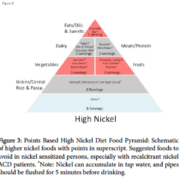Nickel Allergic Contact Dermatitis: Identification, Treatment, and Prevention
Review and Synopsis by Jalal Maghfour, MD and Alina Goldenberg, MD of Original Peer-Reviewed Article:
Silverberg NB, Pelletier JL, Jacob SE, Schneider LC; SECTION ON DERMATOLOGY, SECTION ON ALLERGY AND IMMUNOLOGY. Nickel Allergic Contact Dermatitis: Identification, Treatment, and Prevention. Pediatrics. 2020;145(5):e20200628. doi:10.1542/peds.2020-0628
Nickel (Ni) remains one of the most common causes of allergic contact dermatitis (ACD), a type IV hypersensitivity reaction, since the publication of its first case in 1888 by Dr. George Henry Fox. This metal continues to be highly prevalent in every day goods within the US. Ni ACD is considered a public health issue and has been gaining international attention.
The impact of nickel on both adults and children has been increasingly reported in the literature. However, Ni ACD is primarily a disease of the young as it rarely affects elderly (> 60 years). In this synopsis, we provide a brief overview on an article written by Silverberg et al. in which the authors discussed epidemiology, clinical presentation, pathogenesis and management of Ni ACD among pediatric population.
With the discovery of Ni in the 18th century and advancement in the steel industry in early 19th century, Ni has become commonly utilized among manufacturers and is now considered the 5th most common metal in the world. Ni ACD may manifest as mild pruritus with ill-defined erythema to diffuse and pronounced redness with oozing and bullae. Classically, Ni ACD presents as an erythematous lichenified papule/plaque and matches the object touching the specific skin area. Any parts of the body can be affected by nickel.
Ni ACD has a multifactorial etiology with a combination of genetic and environmental factors. Contact with nickel is simply not enough for a reaction to occur. The following conditions must be met for both induction and elicitation phase to occur: 1) Contact with a metal containing corroded Ni, 2) degree of solubility of Ni (higher the solubility the higher ion leakage); 3) Ni ions being absorbed by the skin.
In case of a Ni ACD, the majority of diagnoses are clinical. However, when the cutaneous patterns are atypical, the diagnosis may be difficult in which cases patch testing can be performed. Patch testing is the criterion standard method to diagnose Ni ACD. While it is usually a localized reaction, the appearance of 3 large papules following Ni patch testing strongly suggests a systemic nickel hypersensitization.
Ni ACD can be a diagnostic challenge in AD patients as the morphologic eruption may not match the triggering object. In addition, patients may also experience an exacerbation of their AD. In parallel, adults with psoriasis often experience flare of their disease during a Ni ACD episode. Although Ni ACD is primarily a type IV reaction, immediate hypersensitivity through IgE has been reported as a cause of Ni ACD.
For Ni ACD treatment, this review recommends the avoidance of the offending agent as the next best step in management, followed by the treatment of inflammation with the use of glucocorticoids (potency is based on the affected area). Finally, restoration of the skin barrier is essential. This can be performed with a generous application of emollients.
As exemplified by Denmark and Finland, enacting a national policy to regulate the amount of Ni that a population is exposed to was proven efficacious in reducing the rate of Ni ACD and has increased awareness on the topic among adolescents. There is no such regulation within the US. Because Ni is primarily found in jewelry and ear piercings, it may be beneficial to regulate Ni found in other forms of jewelry, as well as children’s toys, metal protectors for phone which are now increasingly recognized to as a cause of Ni ACD.
Increased production and manufacturing regulations, specific diagnoses and focused avoidance strategies can make Ni ACD a preventable pediatric health issue. As it was shown with European countries, the United States can benefit from limiting Ni exposure to its population. Until then, individual awareness and knowledge of daily objects containing nickel should be encouraged as part of avoidance.





